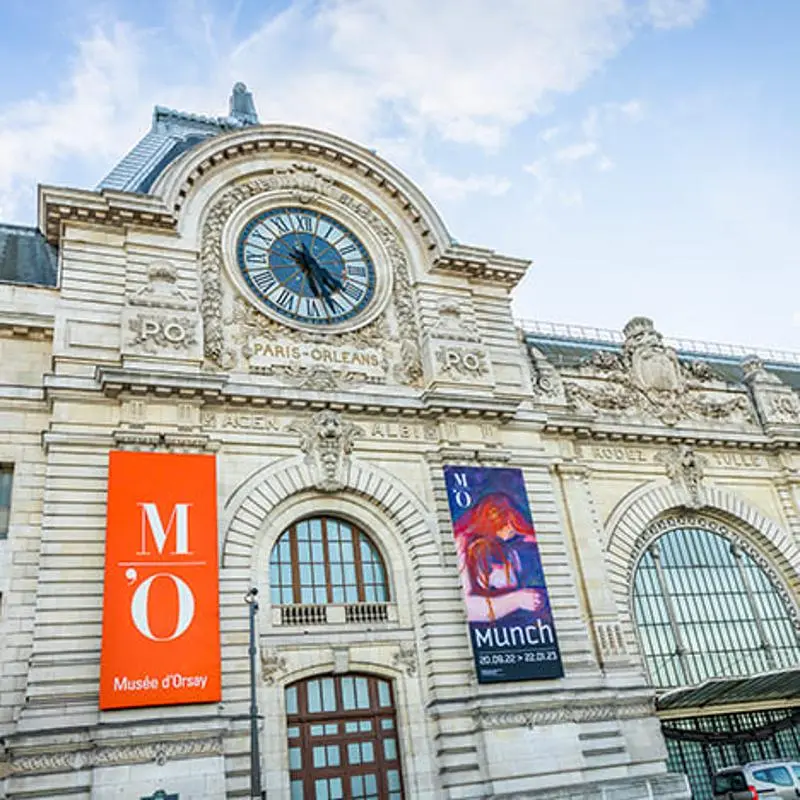How to book Musée d'Orsay luggage storage with Nannybag?
Why is Nannybag the best luggage storage near Musée d'Orsay?
Need a Nannybag review?
Thousands of Nannybag luggage storage reviews are available on Trustpilot
Find luggage storage near Musée d'Orsay
Grab a spot in one of our top locations nearby.
Find your Paris city guide
Frequently Asked Questions
Can't find the answer to your question?
Feel free to contact us!
Where to leave luggage near Musée d'Orsay?
Nannybag luggage storage
lockers Musée d'Orsay
Musée d'Orsay Luggage Storage Guide 2025
If you’ve decided to visit the world-famous Musée d’Orsay, you’ve made a great choice! This enormous art gallery showcases some of the best French art from the 19th century when French art was at the forefront of breaking new ground. The advent of Impressionist paintings introduced by artists such as Delacroix, Money, and Renoir, and Post-Impressionism, a style slightly different due to its use of unnatural colours and geometric shapes that came at the end of the 19th century changed the art world forever, and these styles are celebrated in the magnificent museum and gallery. However, what a pity it would be not to be able to enjoy these masterpieces fully due to being weighed down by any bags and luggage that you have to bring around with you! With Nannybag, you can travel without worrying about your luggage! The service allows you to find easily safe locations on our app or website that are near. Once you’ve found somewhere convenient, you can make a booking and leave your item at the location. The things you have left will be protected with luggage coverage for up to €1000, and free cancellation is included. Check out our reviews to see how this service has helped others, and read below for more information on the service and about the museum itself.
How do I store luggage near Musée d'Orsay with Nannybag?
Storing luggage with Nannybag is easy and only takes a few seconds: you can book from the website or use the Nannybag App, available on the App Store and Google Play. Enter your location in the search bar, and you’ll have many options to store your luggage near you safely. You’ll quickly find luggage storage points in various key Paris locations. There are different ways to refer to luggage storage depending on the place you’re in. However, they’re all referring to the same luggage storage service. In the UK, for instance, you’ll find mentions of left luggage instead of luggage lockers. If so, no worries; it only means you’ll find a storage spot for your belongings.
Is Nannybag luggage storage safe?
To guarantee a worry-free experience, Nannybag protects travelers’ luggage up to €10,000 against any incidents (loss, theft, or breakage) that may occur during the service. Moreover, our Nannies are certified and carefully selected by our company to guarantee their professionalism and hospitality. Customers can also consult the online ratings for Nannybag and comments given to each Nanny by other travelers.
Things to know about Musée d'Orsay
What are the activities to do near the Musée d'Orsay?
Beside the museum is the Musée de la Légion d'honneur et des Ordres de Chevalerie, displaying collections of French military standards, honours, weapons, uniforms, and paintings. There are also beautiful statues to admire just outside the museum representing the six continents. The Jardin de Tuileries and the magnificent Orangerie art gallery are also within walking distance.
Is there a café or restaurant at the Musée d'Orsay?
There is a café serving light meals such as salads and sandwiches, as well as pastries and beverages, located in the museum. Plenty of other restaurant and café options can also be found in the surrounding area.
When is the Musée d'Orsay open?
It is open every day from 9.30 am - 6 pm, except on Mondays when it is closed and Thursdays when it stays open until 9.45 pm.
How much does it cost to enter the Musée d'Orsay?
A standard ticket for the museum costs €16.
Are there any discounts for students or senior citizens?
There is no discount for senior citizens, but under-18s and EU citizens under the age of 26 go free, as do disabled people and their carers.
Where is the Musée d'Orsay located?
The museum is located on the banks of the Seine, in the 7th arrondissement, about a kilometer west of the Île de la Cité.
Are there any guided tours available at the Musée d'Orsay?
Yes, guided tours lasting an hour and a half can be booked on the museum's website. The tickets cost €6 on top of the standard ticket price. Audio guides can also be purchased at the entrance for €5.
Learn more about Musée d'Orsay
The Musée d’Orsay is one of the most popular art museums in Paris. Located on the south west bank of the River Seine in the 7th arrondisement, this museum and gallery is housed in a beautiful old railway station in the Beaux-Arts style, the building, built between 1898 and 1900, is as beautiful on the outside as many of the wonderful artistic masterpieces are on the inside. The old railway station, the Gare d’Orsay, was constructed just in time for the 1900 Paris Exposition, the work of architects Lucien Magne, Émile Bénard, and Victor Laloux. It was built on the site of the Palais d’Orsay, which briefly housed the Council of State but was largely destroyed when it was burned by the soldiers of the Paris Commune. Over the course of the 20th century, the station’s short platforms became unsuitable for newer, longer trains that travelled long distances around the country and Europe. After 1939, it was used only for suburban services and became a large post office during World War Two. By 1970, it had become somewhat redundant as a train station, and plans were approved to demolish the beautiful building; this plan was successfully blocked. Instead, the building was listed as one of the country’s Historic Monuments. Then, the idea was formulated to turn the old building into a new art museum. In 1978, a competition was launched for the rights to design 20,000 square meters of floor space over four levels to form this new museum. The competition was won by Pierre Colboc, Renaud Bardon, and Jean-Paul Philippon, while the Italian architect Gae Aulenti was chosen to design the interior decoration, arrangement, furniture, and fittings of the museum. The arrangement of galleries she designed is very thoughtful and extends over the three main levels, which are located under the atrium of the museum. At ground level, a central nave was formed from the surrounding stone structures that used to form the building's platforms when it was a train station. The structures of the nave divide the vast sculpture and gallery spaces and create orderly units for viewing what’s on display. President Francois Mitterrand opened the museum officially in December 1986. Nowadays, the museum houses some of the most important works from a range of Impressionist and Post-Impressionist artists, mainly French, between 1848 and 1914. Masterpieces from Morisot, Sisley, Monet, Manet, Seurat, Renoir, Degas, van Gogh, and Cézanne are housed in the museum. There is also a collection of sculptures from the most famous sculptors of the 19th century; the museum houses over 2,200 works from the likes of Rodin, Gaugin, and Maillol. With such esteemed and beautiful works on display from some of the most famous artists and sculptors in history and being in such a central location in the city, it’s no surprise that the museum is incredibly popular with tourists visiting Paris. In 2022, 3.2 million visitors passed through the museum, down from 3.6 million in 2019 before the COVID-19 pandemic. Still, it’s a hugely busy, popular destination, so it’s advised to pre-book a ticket or try to go at an off-peak time!




